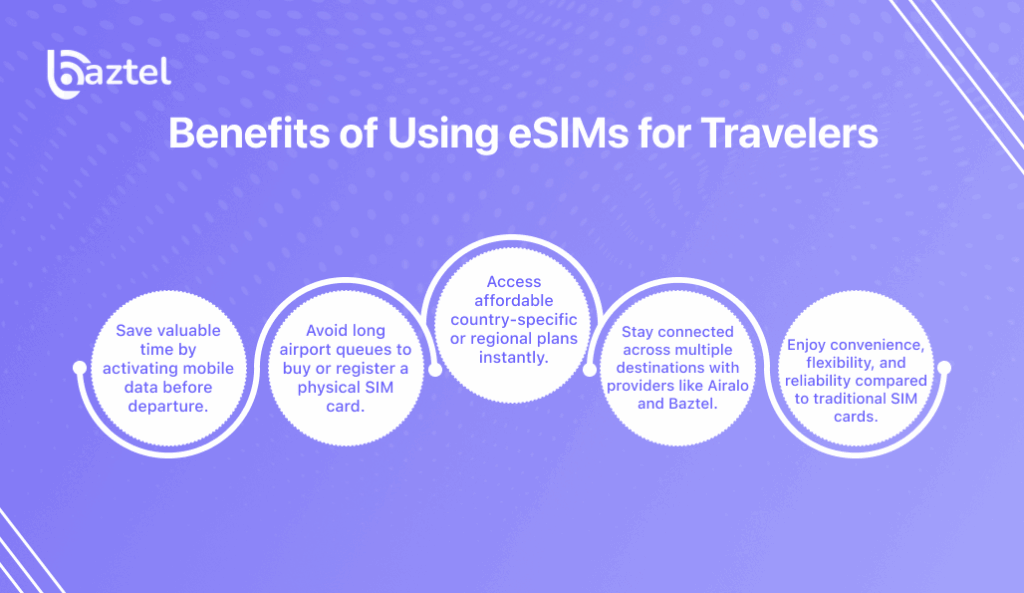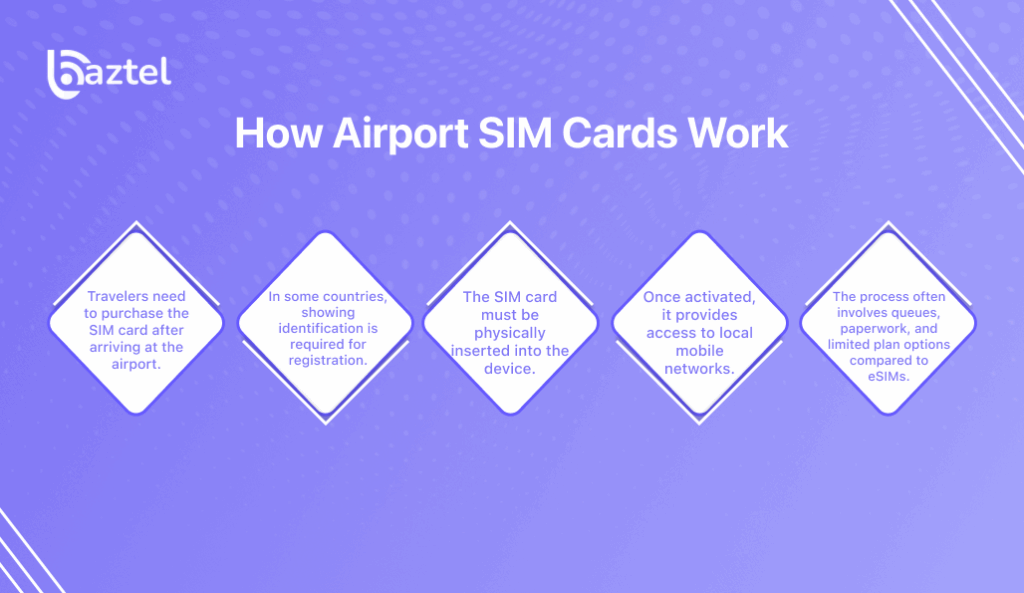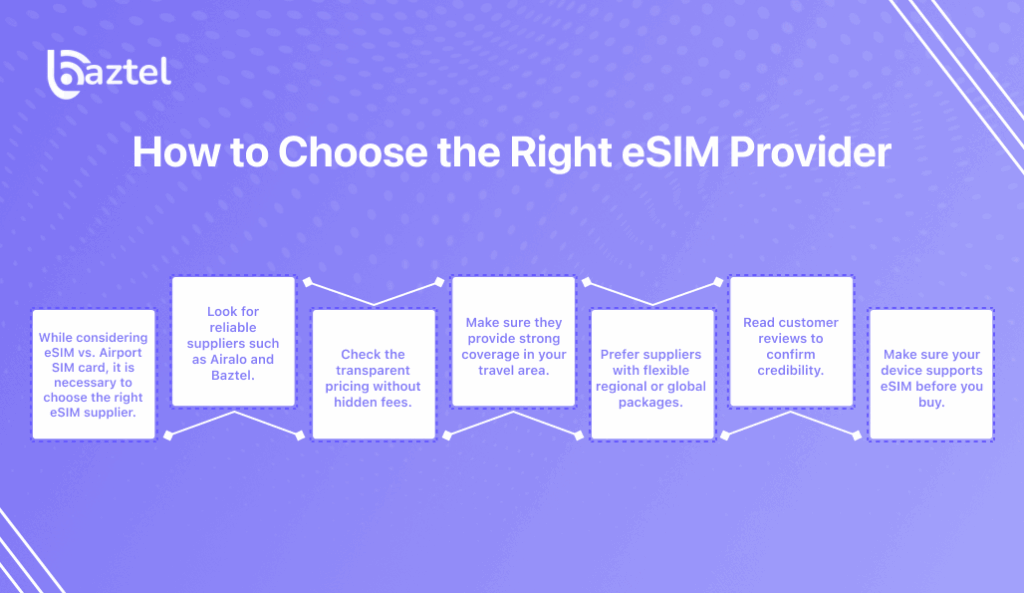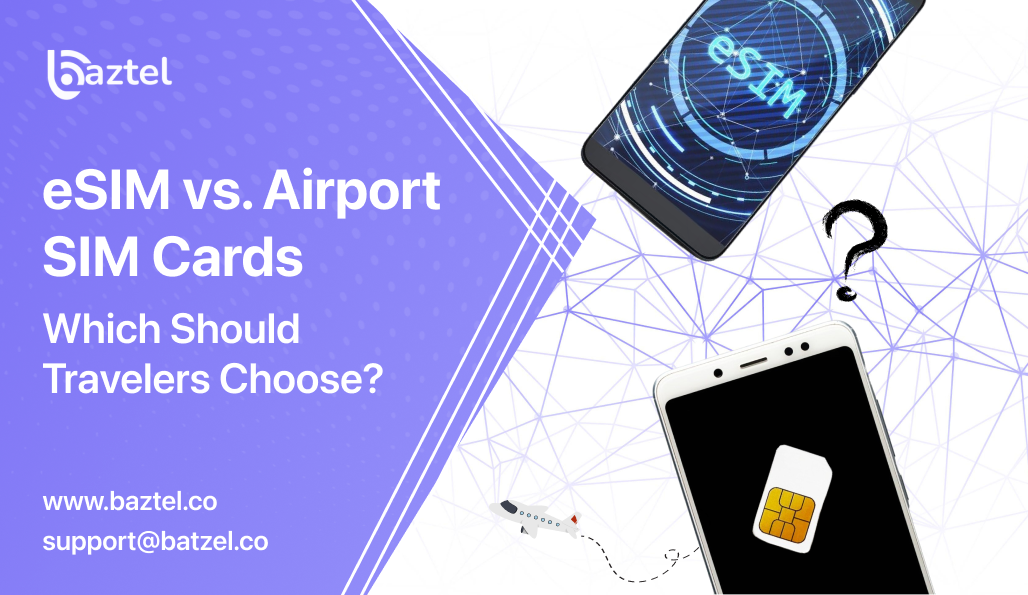Keeping in touch while traveling is not a luxury; it is a requirement. Good internet has become necessary for all types of trips, from navigating Google Maps to sharing experiences, ordering, and keeping in touch with family and friends. Traditionally, passengers used to buy a physical SIM card at the airport after landing. The SIM cards at the airport may be convenient, but they usually do not have many schemes available, and they are more expensive. In the eSIM vs Airport SIM card debate, this highlights why many travelers prefer eSIMs.
The rise of digital solutions has offered a better alternative: eSIMS. With an eSIM, you can immediately activate a mobile plan without the need for a physical card before you leave home. Providers like Airalo and Baztel have made this process simple and cheap by offering country-specific and regional plans that save time and money. This leads to the growing debate on eSIM vs Airport SIM cards, as passengers are now confused about which they should use.
When you compare eSIM vs Airport SIM card, it depends on the preferences of a passenger. Airport SIM cards are popular for their access, and eSIMs quickly become a good option for technology-bearing explorers.
What is an eSIM?
An eSIM is known as a built-in SIM or embedded SIM, a digital version of a SIM card that allows you to connect to the mobile network without including any physical SIM. Unlike the SIM card at the airport, which requires purchase and layout after landing, eSIM can be activated immediately, so in the comparison of eSIM vs Airport SIM card, eSIMs are convenient for passengers.
How eSIMs Work
- eSIMs let you download a mobile data plan directly to your device without needing a physical SIM card.
- Activation is quick and simple through a QR code or a mobile app.
- Once installed, you can store multiple plans on one device.
- Travelers can easily switch between carriers without swapping SIM cards.
- This flexibility makes eSIMs highly convenient for frequent international travelers.
Benefits of Using eSIMs for Travelers

- Save valuable time by activating mobile data before departure.
- Avoid long airport queues to buy or register a physical SIM card.
- Access affordable country-specific or regional plans instantly.
- Stay connected across multiple destinations with providers like Airalo and Baztel.
- Enjoy convenience, flexibility, and reliability compared to traditional SIM cards.
Also Read: https://baztel.co/blog/what-is-esim-card-and-how-does-it-work/
What are Airport SIM Cards?
Airport SIM Card is a physical SIM sold in kiosks or vending machines, usually just after immigration. They provide access to local mobile networks so that passengers can call and use data.
How Airport SIM Cards Work

- Travelers need to purchase the SIM card after arriving at the airport.
- In some countries, showing identification is required for registration.
- The SIM card must be physically inserted into the device.
- Once activated, it provides access to local mobile networks.
- The process often involves queues, paperwork, and limited plan options compared to eSIMs.
Common Features and Limitations
- Easily available for purchase immediately after arrival at airports.
- Usually come with prepaid plans designed specifically for tourists.
- Often more expensive compared to online or eSIM options.
- Plans may have restricted validity periods and limited data allowances.
- Require physical installation, which is inconvenient for travelers switching devices or visiting multiple countries.
eSIM vs Airport SIM Cards: Which Option is Better for Different Types of Travelers?
When it comes to eSIM vs Airport SIM card, the right choice will usually depend on what kind of traveler you are. eSIM is the best solution for active passengers and digital nomads for immediate activation and global use. Backpacking tourists and long-term travelers can also prefer eSIM, as they provide a simple transition between many countries. However, short-term vacation travelers might find Airport SIM Cards easiest for obtaining instant access to local connectivity. All things considered, eSIMs are, in the majority, a more convenient and flexible option for more value than any other option available to travelers today.
Business Travelers
For business travelers, time and reliability are important. eSIMs allow instant setups before arrival and ensure uninterrupted connection for meetings and communication. In a comparison of eSIM vs. Airport SIM cards, eSIM clearly wins for professionals who cannot postpone the airport kiosks.
Backpackers and Long-Term Travelers

Backpacking tourists and long-term travelers often drive in many countries. eSIMs of providers such as Baztel make it easy to switch between areas without replacing physical cards. Airport SIM cards are limited to a country, expensive, and impractical, which creates smart options in the SIM card comparison of eSIMs vs airport SIM cards.
Short-Term Vacationers
For small vacationers, airport SIM cards can be convenient, as they provide local packages of immediate calls and data upon arrival. However, in the choice between eSIM vs Airport SIM card, eSIM still offers flexibility, especially for travelers who prefer to avoid queues and establish connections before the flight country.
Frequent Flyers and Digital Nomads
Frequent flyers and digital nomads require global coverage and trouble-free alternation between destinations. eSIM allows more schemes in one unit and immediate network. The SIM cards at the airport are bound to the same country and are reduced.
eSIM vs Airport SIM Cards: Side-by-Side Comparison
The eSIM vs Airport SIM Card comparison comes down to facilities, cost, and flexibility. eSIM provides immediate setup, affordable plans, and use in many countries with the help of providers such as Airalo and Baztel. Airport SIM card provides a reliable local connection but includes high costs, queues, and limited flexibility. For modern travelers, eSIMs are often smarter alternatives.
| Feature | eSIM | Airport SIM Cards |
| Convenience & Setup | Activate instantly via QR code or app before arrival; no queues or physical card needed. | Must purchase at airport kiosks, show ID, and insert a physical SIM card; often involves waiting in long lines. |
| Coverage & Reliability | Works with multiple carriers; providers like Airalo and Baztel ensure strong coverage in different regions. | Connects to one local carrier; generally reliable but limited to that single network. |
| Cost & Fees | Transparent pricing, affordable data plans, and regional packages available; no hidden activation fees. | Often more expensive; tourist SIMs may include hidden costs or limited data validity. |
| Data Speed & Performance | Access to 4G/5G networks with option to switch carriers for better speeds. | Tied to one local carrier, which may not always offer the best speed everywhere. |
| Security & Safety | No physical card to lose or damage; digital setup reduces risks of SIM cloning. | Can be lost, damaged, or cloned; requires safe handling of a physical SIM. |
| Flexibility for Multi-Country Travel | Store multiple plans in one device and switch easily across destinations. | Works only in the country of purchase; requires buying new SIM cards in each destination. |
Pros and Cons of eSIMs
The main advantages of eSIMs explain why many travelers prefer them in the debate on eSIM vs Airport SIM card. With instant activation, flexibility to switch to the carrier, and cheaper international packages from providers such as Airalo and Baztel, eSIMs physically solve problems by providing the best connection in many countries.
Advantages
- Instant activation before arrival; no need to search for kiosks.
- Easy to switch between multiple carriers and plans.
- Providers like Airalo and Baztel offer affordable international packages.
- No physical SIM card to lose or damage.
- Ideal for multi-country travel with seamless connectivity.
Disadvantages
- Not all devices support eSIM technology.
- Requires internet access for initial setup.
- Some local carriers may not be included in eSIM plans.
- Limited availability in certain remote destinations.
Pros and Cons of Airport SIM Cards
Airport SIM card is still an option compared to an eSIM vs Airport SIM card, which offers easy availability without an immediate local connection, a prepaid tourist package, and compatibility problems. However, they often reach high costs, require papers or queues, and lack flexibility for travel with several countries, making them less practical for international passengers.
Advantages
- Immediate local connectivity upon purchase.
- Often includes prepaid tourist packages with calls and data.
- Widely available at airport kiosks and shops.
- No need for device compatibility checks.
Disadvantages
- Can be expensive compared to eSIMs.
- Long queues and ID verification may be required.
- Works only in the country of purchase.
- Limited flexibility when traveling to multiple destinations.
Practical Tips for Travelers
The practical travel schedule involves understanding the strength of both options in the SIM card. Passengers can ensure a useful Internet by selecting the terms of a reliable eSIM provider, double-checking airport SIM cards, and having a backup connection. These tips help to avoid surprise, reduce costs, and guarantee stress-free global connection.
How to Choose the Right eSIM Provider

- While considering eSIM vs. Airport SIM card, it is necessary to choose the right eSIM supplier.
- Look for reliable suppliers such as Airalo and Baztel.
- Check the transparent pricing without hidden fees.
- Make sure they provide strong coverage in your travel area.
- Prefer suppliers with flexible regional or global packages.
- Read customer reviews to confirm credibility.
- Make sure your device supports eSIM before you buy.
Also Read: https://baztel.co/blog/are-esims-safe/
Things to Check Before Buying an Airport SIM Card
- When you compare eSIM vs. Airport SIM card, you should consider both cost and convenience.
- Check the validity period for the SIM scheme to ensure that it covers the duration of your journey.
- Review data restrictions to avoid getting cut off from the Internet during your trip.
- Look for hidden fees such as activation or registration fees.
- Confirm whether the purchase in your destination country requires identity.
- Consider the overall value to avoid supervision of limited tourist packages.
Backup Solutions for Internet Access Abroad
- In the debate on eSIM vs Airport SIM card, it is smart to have a backup for connection.
- Take a portable Wi-Fi device as an alternative to multiple devices.
- Use hotel or public Wi-Fi when available to store mobile data.
- Download offline maps and guides to stay ready in areas with weak signals.
- If your SIM plan goes out of data or coverage, it ensures a backup connection.
Future of Travel Connectivity: eSIM vs Airport SIM Cards
As technology evolves, the way travelers connect abroad is rapidly changing. The eSIM vs. Airport SIM Card debate has been strongly moved to eSIMs, thanks to their convenience, strength, and global compatibility. However, SIM cards in the airport can still be useful in specific cases.
Growing Adoption of eSIM Technology
- More smartphones, tablets, and wearables now support eSIM technology, making it easier for travelers to stay connected globally.
- Providers like Airalo, Baztel, and Holafly are expanding with regional and global eSIM packages.
- Instant activation, flexibility across countries, and eco-friendly benefits are driving eSIM adoption among travelers.
Will Airport SIM Cards Become Obsolete?
- Airport SIM cards are still popular with short-term tourists who prefer physical cards and local conversation packages.
- However, the availability of eSIM and digital travel trends suggests that the SIM cards at the airport can gradually decrease in popularity.
- In the long term, eSIM’s travel connection will probably dominate, but airport SIM cards will be present for travelers with old equipment or passengers who require local plans.
Comparison Table: Future of eSIM vs Airport SIM Cards
The future of travel connectivity is clearly bending towards eSIM technology, which offers multiple -access, strength, and instant setup. While the SIM cards at the airport may not disappear completely, their role will shrink, mainly serving short-term passengers. For the long term, eSIM is best.
| Feature | eSIM (Future Trend) | Airport SIM Cards (Future Role) |
| Adoption Rate | Rapidly growing with device support and global use | Slowly declining, limited to specific markets |
| Convenience | Instant activation, no kiosks needed | Requires kiosk purchase and setup |
| Coverage | Multi-country and global plans available | Limited to single country |
| Sustainability | Eco-friendly, no plastic SIM cards | Physical cards add to plastic waste |
| Target Travelers | Business travelers, digital nomads, frequent flyers | Short-term tourists, users of older devices |
Conclusion: eSIM vs Airport SIM Cards
The eSIM vs Airport SIM Card comparison shows a major change in how travelers are linked in today’s world of digital technology. Airport SIM cards have been a local connection option, but they often include high costs, long queues, limited flexibility, and country-specific restrictions. Although they can still match travelers with short-term holidays, their practicality slowly drops.
On the other hand, eSIM’s future represents global travel connections. With providers such as Airalo and Baztel, passengers can immediately buy and activate mobile data before departure. This eliminates stress from finding kiosks after a long flight, provides transparent pricing, and allows alternation between carriers in many countries.
When you compare an eSIM vs Airport SIM card, it depends on your travel style. Professional passengers, backpackers, frequent flyers, and digital nomads mostly use eSIM, while airport SIM cards are mostly used by random tourists who prefer local call facilities. Overall, eSIM is the most practical and cost-effective alternative for most modern travelers.
FAQ
1. What is the main difference between eSIM and airport SIM cards?
The main difference between eSIM vs Airport SIM cards is convenience. An eSIM can be activated immediately using a QR code or app before traveling, while a SIM card should be purchased at the airport, should have the ID checked, and then be specified on arrival. eSIM can save time, reduce the experience, and provide better convenience to frequent flyers.
2. Are eSIMs compatible with all devices?
Not every smartphone or every device supports eSIM. In the eSIM vs Airport SIM Card discussion, Airport SIM cards work in any unlocking of a telephone, while eSIMs must be examined for compatibility. Before procurement, a passenger should confirm that their device supports eSIM, either with a service such as Baztel or others, so they have no trouble connecting.
3. Which option is cheaper, eSIM or airport SIM cards?
When it comes to cost in eSIM vs Airport SIM Cards, eSIMs often provide more affordable, transparent pricing through apps like Airalo and Baztel. Airport SIM cards may be more expensive with hidden charges or limited validity. For budget-conscious travelers, eSIMs usually deliver better value across multiple countries.
4. Can I use eSIMs in multiple countries?
Yes, eSIMs are ideal for multi-country travel. In the eSIM vs Airport SIM Cards debate, eSIMs clearly win for flexibility. Providers like Airalo and Baztel offer regional or global plans covering several destinations, while airport SIM cards are limited to one country, requiring new purchases at every border.
5. Will airport SIM cards eventually disappear?
Airport SIM cards may not disappear completely but their role will shrink. In the eSIM vs Airport SIM Cards discussion, eSIMs are becoming the dominant option due to instant activation, global coverage, and eco-friendly benefits. Airport SIMs will likely remain useful for tourists with older devices or local call needs.
Blog Author
Peter
Peter started BazTel.co to make mobile internet easier for travellers. He noticed how tough it was to find good network options while visiting new countries. That’s when he built BazTel — a place where anyone can buy eSIMs online without confusion or long steps. He believes tech should be simple and useful, not complicated. When he’s free, he likes to travel, test BazTel himself, and keep improving it based on real user problems.

 Botswana
Botswana Zambia
Zambia Congo
Congo Colombia
Colombia China mainland
China mainland Chile
Chile Chad
Chad Central African Republic
Central African Republic Canada
Canada Cameroon
Cameroon Cambodia
Cambodia Burkina Faso
Burkina Faso Bulgaria
Bulgaria Brunei Darussalam
Brunei Darussalam Brazil
Brazil Aland Islands
Aland Islands Bosnia and Herzegovina
Bosnia and Herzegovina Bolivia
Bolivia Belgium
Belgium Belarus
Belarus Bangladesh
Bangladesh Bahrain
Bahrain Azerbaijan
Azerbaijan Austria
Austria Australia
Australia Armenia
Armenia Argentina
Argentina Algeria
Algeria



